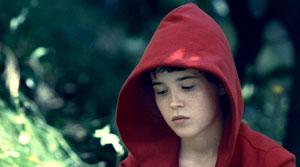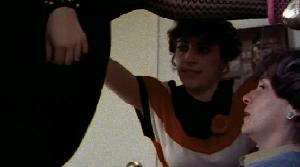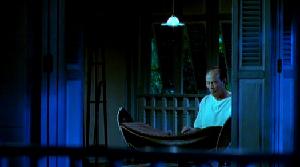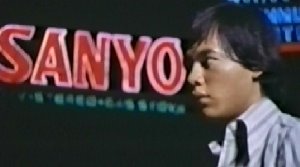
Ashes of Time (Wong Kar Wai, 1994)
Cantonese Title: Dung che sai duk
In Wong Kar Wai's Ashes of Time, there is no present. Wong allows his characters to narrate their respective plots in a way wherein the imagery shown seems to be more like splices of memory rather than events taking place in the present. It's not the wisest of cinematic narrative techniques. For sure, it's not one to ensure commercial success (Ashes of Time was a box office failure especially when compared to its huge budget and the amount of time to make it). However, the technique ensures the film a detachedness that turns the beautiful visuals into moving poetic images rather than plot-driving mechanisms. Indeed the film feels and moves like a dream --- disconnected and inhabits a vague passionate form that sweetly blends into a mythical reality.
Ashes of Time took many years to make that Wong made Chungking Express (1994) in the middle of the former's production. It's every Hong Kong director's dream project. It includes almost everyone who's somebody in Hong Kong show business, and as cinematographer, Wong only had Christopher Doyle, arguably the best cinematographer around, to work with. Wong also had legendary Sammo Hung to direct the action choreography (although I really can't tell since the action is filmed like a mnemonic blur to insist on the artistry of the fight scenes). But in the hands of Wong, almost all of the intrinsic positive aspects of the production is completely wiped off, and instead, reshuffles everything to make a masterpiece that is completely his own, not Doyle's, not Hung's, not even the top actors and actresses that are in his employ. Ashes of Time is such a dizzying yet heartfelt vision that it is undeniably Wong's.
The plot is based on a traditional Chinese tale, but is transformed into an episodic glance of the intimate love lives of sword fighting heroes. It's a rather thoughtful transformation. When typical films of the genre would concentrate on virtues of brotherhood, heroism, and valor, Wong decides to pervade his film with non-virtues of romance, infidelity, burning passions, regret, and mistrust. Ouyang Feng (Leslie Cheung) is an agent for mercenaries. People with problems would come up to his desert house to negotiate murders and assassinations. Yearly, his friend Huang Yaoshi (Tony Leung Ka-fai) would visit him in his lonely abode. One time, Huang Yaoshi brings him a pot of magical wine which erases memories of the past. Ouyang Feng doesn't drink a drop of the wine, but Huang does so. One of Ouyang Feng's clients is Yang (Brigitte Lin), a warrior who dons both masculine and feminine attire and is known as Yin when she's female, who wants to have Huang Yaoshi killed for breaking a promise. Ouyang Feng finds work for a number of mercenaries. One of the mercenaries who used to be employed by Ouyang Feng is a swordsman (Tony Leung Chiu-wai) who longs to be back to his hometown before he turns thirty, the age wherein his doctor predicts he will lose his sight completely. Another warrior that is employed with Ouyang Feng is Hung Chi (Jackie Cheung), a bare-footed yet fast-handed swordsman who is constantly being followed by his wife.
It's not a very easy plot to follow, and Wong complicates the story by telling it with mere glimpses. However, Wong makes one thing clear --- that the film is not interested in heroics but in the repressed emotions and longing that are trapped inside the hearts of these powerful swordsmen. The cinematography tells it all. Wong shoots the action scenes with a sense of perpetual slow motion. It seems that the violence and the sword fights are mere blurs in the memories of these heroes, that it is impossible to coherently put them in visual form. Doyle's camera keeps on detailing faces and other objects of note rather than accurately showing each motion of the sword or piece of flesh that gets wounded or punctured. However, when scenes of intimacy occur such as during a night wherein a longing Yin caresses the body of a sleeping Ouyang Feng, and Ouyang Feng doesn't react since he's imagining the caresses to be from a woman (Maggie Cheung) he has left behing long ago, Doyle's camera suddenly oozes with a passionate intensity that is quite accurate with what humans really recall. It is those precious moments of intense emotions, and not those wherein emotions are heightened artificially by violence and adrenaline, that is retained in our memory.
Ashes of Time is arguably Wong's more ambitious film. With the film, he injects the genre with a very rich human emotional complexity sacrificing narrative coherence, choreographic grace, and literary resonance. Instead, Wong declares these genre caricatures as passionate human beings being tormented by a state of everlasting mnemonic religiosity. It is that torturous adherence to a sorrowful memory that drives them to seek an easy way out by downing a wine that relieves them from memories of the past like in Huang Yaoshi's case, or by merely following a fate dictated by an inescapable past like Hung Chi's travels with his wife would tell. But as Ouyang Feng states in the end, the magical wine is merely a joke, an unrealistic dream, that men wish for but can never really attain.






















